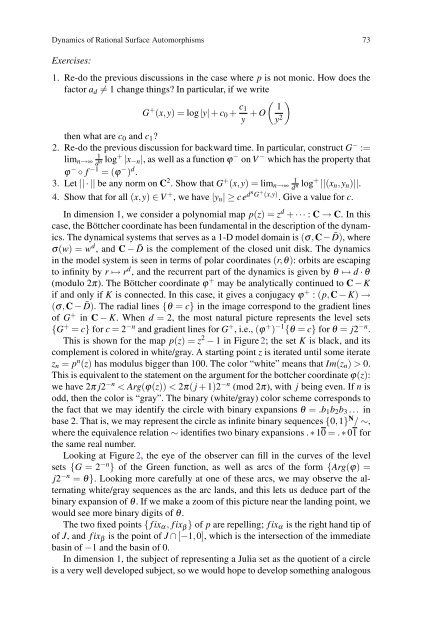Discrete Holomorphic Local Dynamical Systems
Discrete Holomorphic Local Dynamical Systems
Discrete Holomorphic Local Dynamical Systems
You also want an ePaper? Increase the reach of your titles
YUMPU automatically turns print PDFs into web optimized ePapers that Google loves.
Dynamics of Rational Surface Automorphisms 73<br />
Exercises:<br />
1. Re-do the previous discussions in the case where p is not monic. How does the<br />
factor ad �= 1 change things? In particular, if we write<br />
G + (x,y)=log|y| + c0 + c1<br />
�<br />
1<br />
+ O<br />
y y2 �<br />
then what are c0 and c1?<br />
2. Re-do the previous discussion for backward time. In particular, construct G − :=<br />
limn→∞ 1<br />
d n log + |x−n|, as well as a function ϕ − on V − which has the property that<br />
ϕ − ◦ f −1 =(ϕ − ) d .<br />
3. Let ||·||be any norm on C 2 . Show that G + (x,y)=limn→∞ 1<br />
d n log + ||(xn,yn)||.<br />
4. Show that for all (x,y) ∈ V + ,wehave|yn|≥ce dn G + (x,y) .Giveavalueforc.<br />
In dimension 1, we consider a polynomial map p(z)=z d + ··· : C → C. Inthis<br />
case, the Böttcher coordinate has been fundamental in the description of the dynamics.<br />
The dynamical systems that serves as a 1-D model domain is (σ,C− ¯D),where<br />
σ(w) =w d ,andC − ¯D is the complement of the closed unit disk. The dynamics<br />
in the model system is seen in terms of polar coordinates (r,θ): orbits are escaping<br />
to infinity by r ↦→ r d , and the recurrent part of the dynamics is given by θ ↦→ d · θ<br />
(modulo 2π). The Böttcher coordinate ϕ + may be analytically continued to C − K<br />
if and only if K is connected. In this case, it gives a conjugacy ϕ + : (p,C − K) →<br />
(σ,C − ¯D). The radial lines {θ = c} in the image correspond to the gradient lines<br />
of G + in C − K. Whend = 2, the most natural picture represents the level sets<br />
{G + = c} for c = 2 −n and gradient lines for G + , i.e., (ϕ + ) −1 {θ = c} for θ = j2 −n .<br />
This is shown for the map p(z) =z 2 − 1inFigure2; thesetK is black, and its<br />
complement is colored in white/gray. A starting point z is iterated until some iterate<br />
zn = p n (z) has modulus bigger than 100. The color “white” means that Im(zn) > 0.<br />
This is equivalent to the statement on the argument for the bottcher coordinate ϕ(z):<br />
we have 2π j2 −n < Arg(ϕ(z)) < 2π( j + 1)2 −n (mod 2π), with j being even. If n is<br />
odd, then the color is “gray”. The binary (white/gray) color scheme corresponds to<br />
the fact that we may identify the circle with binary expansions θ = .b1b2b3 ... in<br />
base 2. That is, we may represent the circle as infinite binary sequences {0,1} N / ∼,<br />
where the equivalence relation ∼ identifies two binary expansions . ∗ 10 = . ∗ 01for<br />
the same real number.<br />
Looking at Figure 2, the eye of the observer can fill in the curves of the level<br />
sets {G = 2 −n } of the Green function, as well as arcs of the form {Arg(ϕ) =<br />
j2 −n = θ}. Looking more carefully at one of these arcs, we may observe the alternating<br />
white/gray sequences as the arc lands, and this lets us deduce part of the<br />
binary expansion of θ. If we make a zoom of this picture near the landing point, we<br />
would see more binary digits of θ.<br />
The two fixed points { fixα, fix β } of p are repelling; fixα is the right hand tip of<br />
of J, and fix β is the point of J ∩ [−1,0], which is the intersection of the immediate<br />
basin of −1 and the basin of 0.<br />
In dimension 1, the subject of representing a Julia set as the quotient of a circle<br />
is a very well developed subject, so we would hope to develop something analogous



